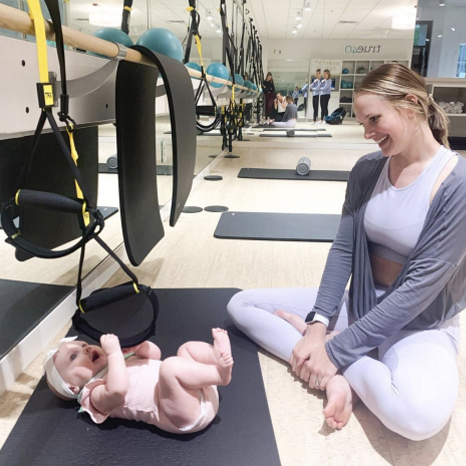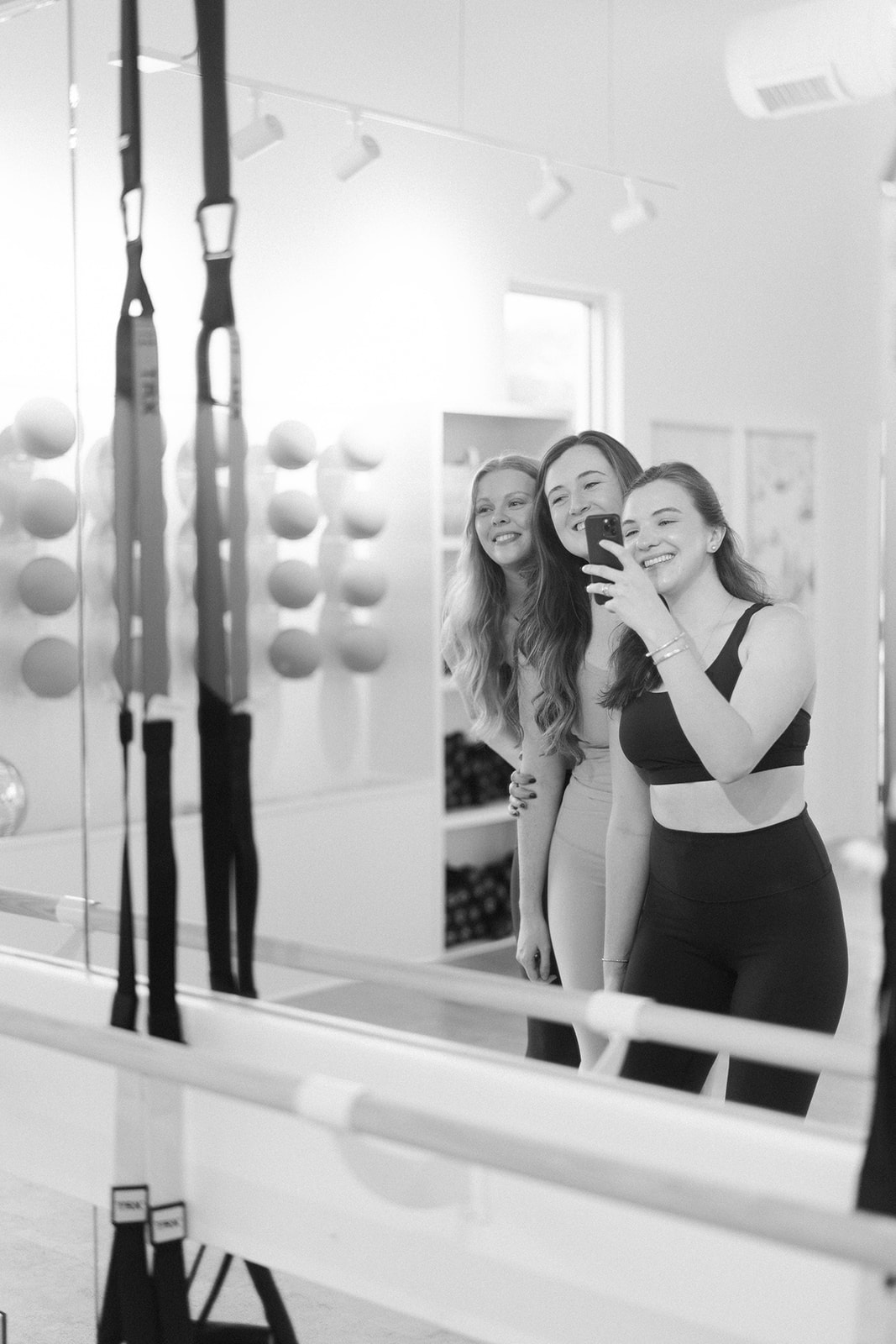about
Our method combines principles of strength training, cardio, barre, Pilates, and yoga. As our inspiring community expands through Alabama and beyond, True40® Studio encourages and empowers people to move true to their bodies, and ultimately step into their highest, truest selves.
categories
trending
Postpartum Workouts: Reclaiming Strength without the Bounce Back Pressure
Medical Disclaimer: This content is for informational purposes only and should not replace professional medical advice. Always consult with your healthcare provider before beginning any postpartum exercise program. Individual recovery timelines vary, and what’s right for one person may not be appropriate for another.
The pressure to “bounce back” after giving birth is high.
Celebrity tabloids celebrate post-baby bodies that “snap back” within weeks. Fitness influencers promise programs to help you “reclaim your pre-baby body.” All of this creates an impossible standard that leaves many new mothers feeling ashamed and behind.
But here’s the truth: your postpartum journey isn’t about bouncing back, it’s about moving forward with grace, strength, and self-compassion. Real postpartum workouts aren’t about punishment or racing against the clock. They’re about reconnecting with yourself and honoring the incredible thing your body just accomplished.

Reframing Strength: From Fragility to Functionality
Too often the conversation around postpartum comes from a harmful narrative – that your body after baby is somehow broken and needs to be fixed. But, that simply isn’t true.
Your body is different. But it’s not broken.
What True Strength Looks Like Postpartum
Your body just grew and delivered a human being. It navigated months of incredible changes from expanding to accommodate new life to the intense process of childbirth. That’s not fragility; that’s phenomenal strength!
True postpartum strength isn’t about snapping back to your pre-pregnancy shape or fitting into old jeans. It’s about honoring what your body accomplished and supporting it through recovery. It’s about viewing movement as a gentle path to reconnecting with yourself, not as punishment for the ways your body has changed.
Maybe you’re dealing with diastasis recti, that separation of abdominal muscles common after pregnancy. Maybe you’ve noticed hair loss, changes in your core strength, or shifts in your energy levels. These aren’t failures, they’re normal parts of your postpartum story that deserve compassion, not shame.
Body Appreciation Over Perfection
This season of life teaches us something profound: our bodies are meant to be functional, not just aesthetic. Instead of focusing on how your postpartum body looks, try celebrating what it can do. Can you lift your growing baby? Carry groceries? Take the stairs? These are victories worth acknowledging and celebrating!
The postpartum period—which, by the way, continues for months postpartum and often well beyond the traditional “fourth trimester”—invites us to value resilience over appearance. Your body is learning to trust itself forward, not backward. There’s no going back to who you were before because you’ve evolved into someone new.
Understanding Your Postpartum Body: The Foundation for Movement
Before diving into specific postpartum workout plans, it’s important to understand what you’re working with. You’ve got to meet your new body where it is, and give it space to recover and build strength in new ways.
The Postpartum Timeline: Patience Over Pressure
How long is postpartum, really? While medical professionals often refer to the first six weeks postpartum as the initial recovery period, the truth is that postpartum recovery continues for at least a full year, and in many ways, your body continues adapting long after that.
The early weeks postpartum look different from months postpartum. Whether you had vaginal births or a cesarean delivery, your body needs time to heal. Hormonal changes affect everything from your energy levels to your joint stability. If you’re experiencing postpartum depression or other emotional shifts, these impact your physical readiness for exercise too.
Give yourself permission to move on your body’s timeline, not social media’s expectations.
Your Pelvic Floor After Pregnancy: Strength, Not Shame
Pelvic floor changes affect nearly every woman after giving birth, but they are often overlooked. Your pelvic floor muscles supported your baby throughout pregnancy and stretched significantly during childbirth. This is normal, and it can impact your workouts, as well as other aspects of your daily life.
Some women experience pelvic organ prolapse or other pelvic floor challenges. If this applies to you, know that you’re not alone, and help is available. Simple awareness exercises—like focused breathing while lying flat on the floor with your feet flat—can be a gentle starting point, long before you’re ready to go back to the gym. In some cases, you might find it helpful to work with a physical therapist to strengthen and heal your pelvic floor muscles.
Your pelvic floor health is connected to your overall core strength and plays a crucial role in returning to physical activity safely.
What Postpartum Movement Can Look Like: Finding Your Flow
Now for the exciting part—discovering how postpartum workouts can support your journey back to yourself. Along the way it will be important to check in with yourself.
How are you feeling during and after your workouts? Are you tired or more energized? What movements felt good? What didn’t feel so good? What can you adjust next time?
These are all important things to ask yourself as you start to reconnect with physical movement and activity. And it’s totally okay if what worked for you before doesn’t fit where you’re at right now.
Low-Impact, High-Support Postpartum Exercise
The most effective postpartum workout plan isn’t necessarily the most intense one. Low-impact, high-intensity classes, such as True40 Studio and other programs like barre and yoga, can offer incredible benefits for postpartum recovery. These methods help rebuild core strength while being gentle on your healing body and joints.
The key is finding an approach that emphasizes control versus surrender—learning to listen to your body each day and adjust accordingly. On some days, you might feel energized and ready for more challenges. Other days, gentle movement might be all you can manage. Both are perfectly valid.
When exploring group fitness options, look for instructors who understand the diverse needs of different life stages and energy levels. At True40, for example, instructors are trained to offer modifications (and some specifically for postpartum recovery) and meet you exactly where you are on any given day.
Essential Postpartum Stretches and Movements
Starting with postpartum stretches can be a beautiful way to reconnect with your body. The cat cow stretch is particularly wonderful for spine mobility and gentle core activation—plus, it feels amazing after months of pregnancy posture changes.
Focus on stretches that address the reality of new motherhood: neck and shoulder tension from nursing and carrying your baby, tight hip flexors from altered movement patterns, and gentle core reactivation that respects your healing muscles and connective tissues.
As you progress, you can gradually rebuild core strength without forcing your body into traditional exercises it might not be ready for. Remember, this isn’t about rushing back to intense physical activity. It’s about supporting your body’s natural healing process.
Instructors Who Understand Your Journey
The right guidance makes all the difference in your postpartum workout experience. Look for instructors who understand that your postpartum workout plan needs to evolve with your recovery. They should be able to help you modify movements, progress gradually, and most importantly, listen to your body without judgment.
Whether you’re six weeks postpartum or six months postpartum, having support from someone who understands the unique challenges of this season can transform your relationship with movement.
Community as Medicine: You’re Not Alone
One of the most healing aspects of returning to fitness postpartum isn’t just the physical movement—it’s the community.
There’s something magical about exercising alongside other women who are walking through similar seasons. Whether they’re dealing with their own postpartum recovery, managing the demands of motherhood, or simply understanding what it means to navigate life in a changing body, these connections matter.
Group fitness classes become more than just workout sessions; they’re spaces where postpartum bodies are normalized, not scrutinized, where you might find yourself next to someone who also hasn’t slept through the night in months, or who understands why you sometimes need to modify a movement because of lingering physical changes.
Belonging That Heals Isolation
The isolation common in the postpartum period is real. Between feeding schedules, recovery, and the overwhelming responsibility of caring for a tiny human, many new mothers find themselves feeling disconnected from their former selves and communities.
Finding your tribe—whether that’s in a fitness studio like True40, a local mom’s group, or an online community—can be as healing as the movement itself. These connections remind you that you’re not alone in your challenges, your victories, or your journey.
Releasing the “Bounce Back” Narrative: A New Definition of Success
It’s time to retire the “bounce back” mentality for good.
Real success in postpartum workouts looks like having more energy to play with your toddler, sleeping better when you finally get the chance, or feeling more like yourself after a good workout. It’s about improving your mood, increasing your strength for daily activities, and the confidence that comes from taking care of yourself.
Your progress won’t be linear. Some weeks, you’ll feel stronger, while other weeks, you might feel like you’re starting over. This is normal. Normalize these fluctuations in strength, motivation, and ability; they’re part of the human experience, especially during this season of significant change.
From “Getting Your Body Back” to “Trusting Your Body Forward”
What if your pre-pregnancy body wasn’t the goal? What if, instead of trying to get back to who you were, you focused on becoming who you’re meant to be now?
Your postpartum body isn’t a downgraded version of your former self. It’s an evolved version. It has new wisdom, new strength, and new capabilities. Yes, it might also have new challenges, ongoing changes like hair loss or energy fluctuations, but these don’t diminish its worth.
Trusting your body forward means working with where you are now, not where you wish you were or where you used to be.
Permission to Be Exactly Where You Are
You have permission to take breaks. To modify workouts. To skip the gym on some days and opt for rest instead. To progress more slowly than the mom next to you, or more quickly than your friend who had her baby around the same time.
Your postpartum workout journey is uniquely yours. In communities like True40’s growing network of studios, there’s space for women in all life phases, including wherever you are in your postpartum story. Whether you’re dealing with the physical recovery of early postpartum or navigating the ongoing changes months later, you belong exactly as you are.
Invitation to Move with Grace: Your Next Steps
Starting postpartum workouts doesn’t require having everything figured out or feeling completely healed. The right time is when it feels right for your body and when your healthcare provider gives clearance, whether that’s at six weeks postpartum or months later.
If you’re ready to reconnect with yourself, even in the midst of change, consider trying your first class at True40—not as self-pressure, but as self-care. Many locations offer childcare support, making it easier to prioritize your wellbeing alongside your little one’s needs. Join a community that honors every stage of womanhood, including exactly where you are today.
October 2, 2025
contact us
819 green springs hwy suite 117
homewood, al 35209
bham@true40studio.com
(205) 326-7524
True40 homewood
819 E Glenn Ave
AUBURN, al 36830
AUBURN@true40studio.com
(334) 521-5121
True40 AUBURN
2201 2nd ave s #201
birmingham, al 35233
bham@true40studio.com
(205) 224-5498
True40 downtown birmingham
160 Morrow Ave. Unit 100
Trussville, AL 35173
phone tbd
monica@true40studio.com
True40 trussville
1490 Northbank Pkwy Suite 190
tuscaloosa, al 35406
(205) 561-6395
ttown@true40studio.com
True40 tuscaloosa
hello@true40studio.com
150 City Street, Suite 100, Gardendale Al, 35071
gardendale@true40studio.com
(205) 940-1378
True40 Gardendale


